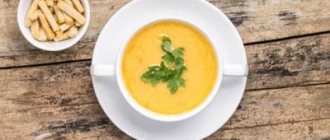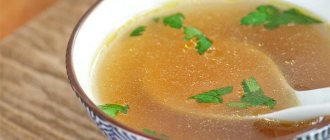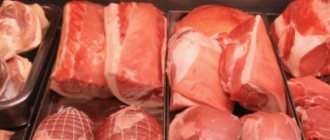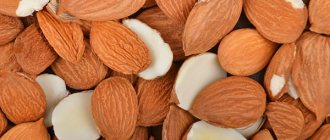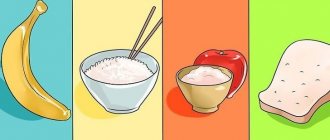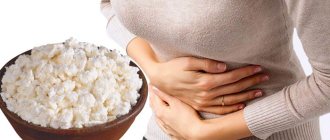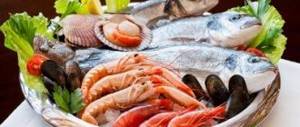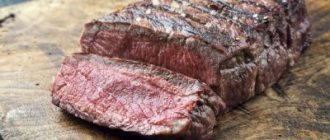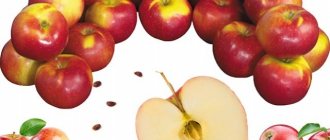Gastroenteritis is an acute or chronic inflammation of the mucous membrane of the stomach and intestines, has a second name - intestinal flu. Accompanied by fever, abdominal pain, and loose, profuse stools. The main reason for its occurrence is the penetration of pathogenic microbes, viruses, parasites into the digestive organs or a consequence of poor nutrition, exposure to chemicals, medications, etc. According to statistics, the incidence of gastroenteritis is in second place after respiratory infections; it affects people at any age, but more often children.
The disease is treated by a gastroenterologist. Diet for gastroenteritis must be included in the treatment plan. In some mild cases, the disease can be managed only with the help of diet therapy, without resorting to medications.
Treatment of digestive disorders without following a diet does not bring results.
Diet goals for gastrointestinal inflammation
The main task of the diet for acute gastroenteritis is to prevent the development of fermentation and putrefactive processes in the digestive organs, reduce the severity of toxic manifestations associated with the activity of pathogenic bacteria, as well as create the necessary conditions to eliminate the inflammatory process in the intestines.
Following a diet allows you to fight the disease much more effectively, avoid dangerous complications and relapses of infection.
Briefly about the disease
Gastroenteritis is characterized by an inflammatory process of the mucous membrane of the stomach and small intestine. The main cause of development is Reoviridae (rotavirus infection), it enters the human body through household contact or through poorly washed vegetables and fruits. Sometimes the infection spreads to the oral mucosa and larynx. When inflammation occurs in the large intestine, the disease is called gastroenterocolitis.
Gastroenteritis can be acute or chronic. You can reduce the risk of intestinal infection by following good hygiene.
Symptoms of gastroenteritis are as follows:
- nausea;
- vomiting and diarrhea;
- pain in the abdominal area;
- malaise, weakness.
It is worth noting that the acute, chronic form of the disease is considered quite serious for the health of adults and children. However, with timely implementation of therapeutic measures, the prognosis will be positive.
General rules of nutrition for gastroenteritis
The diet for gastroenterocolitis in adults and adolescents is based on foods that do not provoke increased stomach acidity and active intestinal motility. It is also important to exclude food, which is a favorable environment for the growth of bacteria.
Authorized Products
In a hospital setting, meals are prepared using a special technology, which eliminates the risk of malnutrition during treatment, but at home such a risk is present, and therefore, in order to avoid deterioration of well-being and progression of pathology, it is necessary to clearly know what can and cannot be eaten with gastroenteritis. Below is a list of permitted foods and dishes:
- lean pureed fish cooked in water or steamed;
- steam cutlets from turkey, chicken, veal;
- unsweetened biscuits, crackers made from wheat bread;
- calcined cottage cheese, passed through a sieve;
- light meat broths;
- oatmeal porridge;
- rice and semolina porridges prepared without milk;
- lean soups with a slimy consistency;
- steam omelette;
- boiled vegetables in the form of puree;
- jelly from non-acidic berries and fruits;
- semolina or rice steam pudding;
- once pureed buckwheat.
After several days of treatment, in some patients, diarrhea may give way to constipation, then it is worth including light plum compote, applesauce in the diet and temporarily eliminating semolina and rice dishes.
Prohibited Products
As can be seen from the above list, the diet for intestinal enterocolitis includes a varied diet, without imposing a ban on animal products. However, it is worth remembering that much depends on the method of preparing the conditionally permitted product. For example, lean beef is suitable for consumption only when pureed and must be steamed . If the same beef is fried or served to the patient in a whole piece, this may cause an exacerbation of the disease and a decrease in the effectiveness of treatment. Such nuances are very important to consider, especially when it comes to feeding a sick child.
Prohibited dishes and products for gastroenteritis include:
- any products made from butter dough;
- chocolate, honey, jam;
- cheese, whole milk, cream, sour cream, full-fat cottage cheese;
- smoked, fried, pickled, canned and overly salted foods;
- fatty varieties of fish, meat and poultry;
- rich meat broths;
- sausage, frankfurters, lard;
- sweet yoghurts;
- fried, hard-boiled and raw eggs;
- millet, pearl barley and barley porridge;
- pasta;
- all legumes (lentils, beans, peas);
- sauces and spices;
- fresh vegetables, fruits and berries.
It is recommended to treat butter with caution, but it is not a strictly prohibited product and in small quantities is served to inpatients for breakfast in its natural form or as an additive to ready-made meals.
What can and cannot be drunk when sick?
Drinking plenty of fluids is one of the main essential conditions for treatment, since with salmonellosis, dysentery, infection caused by rotavirus and other bacterial, parasitic or toxic types of gastroenteritis, the risk of dehydration is extremely high.
Dehydration is the main cause of death that occurs during the acute course of the disease. The highest mortality rates were recorded among the elderly and infants.
In this regard, nutrition for gastroenteritis in adults and children should be accompanied by regular intake of clean water - at least 2.5 liters per day, including special saline solutions (for example, Regidron). If a child refuses to drink, the famous pediatrician Komarovsky recommends giving the baby 10 ml of water through a syringe or, if possible, from a teaspoon every five minutes. In addition to clean water, it is useful for the patient to consume:
- herbal decoctions;
- berry jelly;
- green tea;
- cocoa with water, coffee without milk (for adults);
- non-acidic juices diluted with water;
- light compotes of blueberries, dogwood, rose hips, quince and black currants.
Drinks such as milkshakes, yogurt, kvass, freshly squeezed or pasteurized juice, coffee and cocoa with milk, and sweet soda are strictly prohibited.
Foods that should not be consumed
One of the conditions for diet therapy for gastroenteritis is avoidance of foods that burden the gastrointestinal tract. The body is weakened during the period of illness and, in order to help it, it is necessary to minimize the load on the gastrointestinal tract.
You should avoid using:
- alcoholic drinks;
- fresh bread, baked goods;
- sodas, store-bought and homemade juices;
- kvass and beer;
- raw berries, vegetables, fruits;
- legumes;
- mushrooms;
- fatty dairy products;
- fried, smoked, pickled, spicy and salty dishes;
- green bananas;
- chocolate;
- sausages, sausages;
- rich broths.
All these products irritate the mucous membranes, they are difficult to process and increase the load on the gastrointestinal tract. Sweet and starchy foods have a negative impact on the intestinal microflora, causing its imbalance. Food prepared with yeast causes fermentation processes, which negatively affects the patient’s well-being. Alcohol slows down recovery. Excluding harmful products from the diet and following a diet will help get rid of the disease and improve bowel function.
Features of baby food for gastrointestinal inflammation
In case of acute enterocolitis, on the first day of the disease, children are prescribed the so-called tea diet, in which the child needs to drink unsweetened warm tea and saline solution in small portions in a volume of about 1.5 liters per day. Next, like adults, children are transferred to table No. 4. However, given the fact that the chemical composition of this diet is inferior, the duration of this diet should be no more than five days. After this, the children are transferred to a more expanded diet - table No. 4b, and then, subject to the onset of stable remission - to table No. 4c.
Infants who were breastfed or bottle-fed switch to lactose-free or fermented milk dry formulas with complementary foods that comply with the above nutritional principles. Rapid improvement occurs when babies consume soy milk, which is often given to infants in hospitals or purchased separately by parents.
Reviews
Dear readers, your opinion is very important to us - therefore, we will be happy to provide feedback on the diet for gastroenteritis in the comments, this will also be useful to other users of the site.
Faina, Volgograd
“I have three grandchildren who are kindergarteners, so our family is familiar with rotavirus infection firsthand. If he brings one, everyone will immediately fall asleep, and their parents will also pick it up, and who will take care of everyone? That's right, grandma. Try to feed such sick people! I have two notebooks filled with dietary recipes, but give everyone something different. It is, of course, understandable: in this state it’s sickening to look at food, but you still need to eat, so I’m hovering over the stove, inventing new dishes. Homemade sausages are especially popular among my sick people - double-rolled chicken fillet mixed with a spoonful of sour cream, a pinch of spices and other ingredients that you have on hand, wrapped in a baking sleeve and boiled. They turn out so tender, they literally melt in your mouth, and they just go with a bang!”
Iraida, Rostov-on-Don
“With gastroenteritis, the main thing is to follow a diet, and this can be very difficult. My husband, for example, cannot live without kebabs, steak and fried potatoes, and scrambled eggs and bacon are his favorite breakfast dish. I ate all my life and nothing happened, and then suddenly it became bad: vomiting, diarrhea, the person was literally dying! They called a doctor - it turned out to be gastroenteritis. They prescribed a diet... Of course, I cook, I almost spoon feed him, but he is no better. The doctor said that in two days it should feel better, but that was not the case! Once I went to the store to buy semolina, I came back and saw that my husband was devouring smoked sausage! And he snacks on a piece of rye bread. I still don’t understand how I didn’t kill him on the spot. I collected all the harmful things that were in the refrigerator and took them to my parents, and he recovered so quickly. I was only offended..."
Diet for gastroenterocolitis
After a day's abstinence from food, the child is fed in small portions 5-6 times a day. Below is an approximate children's menu for gastroenteritis for the day.
Breakfast
Semolina or rice porridge with water, unsweetened black tea, 50-70 g of pureed low-fat cottage cheese.
Lunch
Berry jelly, wheat crackers (2-3 pcs.).
Dinner
Boiled turkey soufflé, rice soup with lean meat broth, pureed buckwheat porridge, rosehip infusion.
Afternoon snack
Unsweetened cookies (1-2 pcs.), cranberry compote.
Dinner
Steam omelette, some pureed vegetables, black tea, crackers.
For the night
Diluted carrot juice.
After 4-5 days, you can start giving your child porridge with milk, as well as low-fat kefir, boiled eggs and black bread in limited quantities . The main condition for expanding the diet is stable remission, but if this is not observed, it is necessary to continue to follow a strict diet until the patient’s condition stabilizes.
What you can and cannot drink while sick
You can drink green, black or herbal tea, plain or still mineral water, rosehip decoction, dried fruit compote, cranberry or lingonberry juice, juices diluted with water. Decoctions based on chamomile, St. John's wort, yarrow, oak bark, sage, thyme, linden, blueberries or bird cherry fruits, and alder cones will help get rid of diarrhea.
Tea with mint or lemon balm with lemon can help relieve nausea. You can add a small amount of honey to drinks. Fermented milk products can restore intestinal flora, so it is advisable to drink kefir, fermented baked milk, and yogurts. Products with bifidobacteria or lactobacilli (yogurt, bifikefir, acidolact) improve digestion, promote the absorption of fats and calcium, stimulate secretory and motor activity of the intestines, destroy pathogenic flora, which speeds up recovery.
Jelly works well, they envelop the mucous membrane, and starch is a sorbent and cleanses the intestines of toxins. If you have gastroenteritis, you should not drink alcohol, milk, cocoa, coffee, freshly squeezed concentrated juices, kvass, coffee, carbonated drinks.
You need to drink at least 2 liters of fluid per day
Recipes for gastroenteritis
It is not difficult to prepare dishes that correspond to therapeutic nutrition for enterocolitis. Despite the presence of strict restrictions, there are still many healthy recipes that allow you to eat varied and, as far as possible, tasty. Below are several ways to prepare dietary dishes.
| Name of the dish | Required Ingredients | Cooking method |
| Steam omelette | Milk (40 ml), egg whites (2 pcs.), salt - about 2 g. | Pour milk into the beaten egg whites in a bowl and add a little salt to the mixture. Place the resulting mass in a special container for steaming and bring until cooked. |
| Beef soufflé | Beef – 70 g, milk – 30 ml., 1 egg, 5 g butter, 1 g salt. | Remove all tendons and fat layers from the meat, then cook for at least 1 hour over low heat. Pass the cooked beef through a meat grinder, pour in the yolk, add salt and mix with the pre-beaten egg white. Place the resulting mass on a greased baking sheet and bake in the oven. Cooking time – 10-15 minutes. |
| Fish meatballs | Pike perch – 120 g, butter – 5 g, rice – 15 g. | To the boiled rice you need to add fish fillet minced twice and melted butter, then add salt and form into meatballs. The dish is steamed. |
| Stewed carrots | Carrots – 2 pcs., wheat flour – 3 g, butter – 15 g, 90 ml milk, 2 g sugar syrup, salt 5 g. | Cut the pre-washed and peeled carrots into small pieces (preferably slices), add salt, place in a sealed container, pour in sugar syrup, 50 ml of water, ½ part of the prepared butter and simmer until soft. After this, milk, flour, and remaining butter are added. The carrots must be stirred constantly, keeping the pan on low heat until the dish is cooked. |
The rehabilitation period is a crucial time, since not only the speed of recovery, but also the risk of relapse of the disease depends on how accurately patients follow the doctor’s instructions. To prevent re-infection or the development of chronic inflammation of the gastrointestinal tract in children, the diet after gastroenteritis should correspond to table No. 4c (within one month after diagnosis). This is complete nutrition, sparing the organs of the digestive system, but at the same time not limiting the child in the substances necessary for the normal functioning of the body.
General recommendations
The main symptoms of gastroenteritis are diarrhea and vomiting. In order not to provoke new attacks, eating food is strictly contraindicated on the first day from the onset of the disease (and, if necessary, two or even three). This will only lead to more irritation of the gastrointestinal tract. The patient’s body is already clogged with waste products of pathogenic bacteria and toxins, which fasting helps get rid of. During this period, it is very important to provide the patient with a sufficient amount of water - the most ordinary bottled water, without gas, dyes, flavors and similar harmful substances. You can offer the patient a weak decoction of chamomile flowers or weak tea without milk and sugar.
What to pay attention to
There are several factors that should be taken into account when dieting:
- Infants who are sick cannot be weaned, you can only reduce the number of feedings and replace some of them with fermented milk products.
- Sick children should not be hungry, because they need strength to fight the disease. Fasting is permissible only on the first day of illness.
- During an intestinal infection and during the recovery period, new foods are not introduced into the child’s diet.
- You can cook any food only by steaming, in the oven or boiling.
- Ready-made dishes should not be heavily salted; a minimal amount of salt is acceptable.
- All food and drink should be at human body temperature - this promotes better absorption of foods.
Sick children should not be forced to eat; this will not bring any health benefits. But parents should ensure that the gaps between feedings are not too long.
You should not give unripe bananas to patients. These fruits contain too much starch, which is difficult to digest. If there are green areas on the peel, then immediately before eating, immerse the bananas in boiling water for a couple of seconds.
